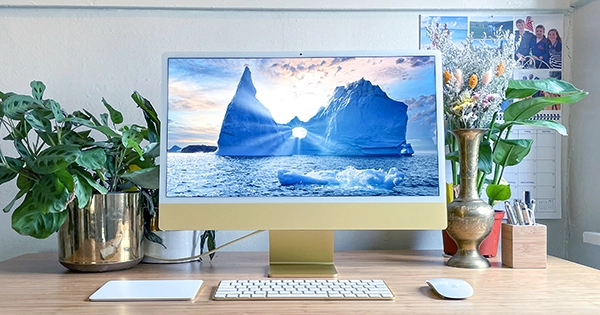Even if you opt to choose the parts and assemble the computer yourself, buying a new computer to replace a failing one typically requires a sizable cost. However, since I didn’t want to upgrade my primary PC, I chose to go a different path and purchase a refurbished system.
Back in the summer, I created a digital dashboard for my office using an outdated monitor and a weak tiny PC. It runs on four-year-old technology, but unlike the Echo Show 15 that now hangs in my kitchen, it is very customisable and has all the information I need each day readily available at a glance, including my calendar and the most recent Tom’s Guide tales.
My digital dashboard’s little PC, however, started performing weirdly and shutting off on its own last week. I opened it up, cleared the CMOS, reseated the RAM, and even again applied thermal paste to the CPU, but to no avail. I am experienced in building PCs. My little PC had vanished into the big sky-based components bin.
I could have replaced it with one of the greatest small PCs, but I preferred a less expensive alternative since I knew I could find something that would satisfy my needs without breaking the bank if I looked long and hard enough. Although I’m happy with the outcome, there were undoubtedly some shocks along the line.
My small PC was already on its last legs when I knew it would eventually die, so I started looking for alternatives to power my digital dashboard.
I thought of using a Raspberry Pi because I knew that any device with a browser would function as I used DAKboard to set it up. Although the Raspberry Pi 4B could be purchased for as little as $35 at launch, good luck locating one for less than $175 today due to supply chain concerns.
I also thought about employing one of the top streaming devices since I already had a Fire Stick 4K Max that I had purchased during Prime Day in an effort to streamline my digital dashboard setup. The Amazon Silk browser allowed me to access my DAKboard, but there is no way to use a Fire Stick in portrait mode.
I went back to DAKboard’s website during my quest for a cheap Raspberry Pi substitute and thought about purchasing a DAKboard CPU 4. But while I really love using a vertical monitor to complete some tasks, this gadget is really just a Raspberry Pi 4B with a custom enclosure for $170, plus I wanted the extra flexibility that Windows offers.
This brought me back to Amazon, where I came across several used business workstations while looking for a good tiny PC. Despite not being as flashy, these computers offer more than adequate power for my use case. Despite finding various versions from manufacturers like Dell and HP for around $200, I chose a Lenovo ThinkCentre M910q Tiny ($169, Amazon(opens in new tab)) because I’ve always liked the style of the device and the combination of its black and red color.
A few days later, a sizable brown box from Amazon containing my new tiny PC—or rather, mini PC that had been renewed—arrived. There included a USB Wi-Fi adaptor, a wireless keyboard, and mouse in addition to the gadget and its power supply. Say what?
My new Lenovo ThinkCentre Tiny didn’t have Wi-Fi or Bluetooth, despite the listing page indicating that this particular setup did. Fortunately, the lack of on-board Wi-Fi wasn’t a deal breaker because I had already intended to connect my router via Ethernet cable after moving it into my office. Because there is no pairing process and there is less lag, I actually prefer using the USB 2.4 GHz dongles that come with many mice and keyboards instead of Bluetooth.
I didn’t thoroughly check the rear I/O before hitting “Buy Now” since I was so happy to locate the PC I’d been eyeing since 2015 for a wonderful price. Instead of two DisplayPort ports, I thought this current PC would include at least one HDMI port. I utilized a DisplayPort to HDMI adapter as I had already run an HDMI connection to my wall-mounted display, but I was able to test the system using a DisplayPort to HDMI cable before installing it in its final location.
I went back to Amazon to see if any other used workstations for businesses had HDMI ports, but none of them did. After a little more investigation, I discovered the solution: adding a DisplayPort connection to a PC doesn’t cost device manufacturers anything, while adding an HDMI port costs “$10,000 per high-volume manufacturer + $0.04 per device,” according to the comparison website Diffen (opens in new tab).
The rest of the specifications for my refurbished Lenovo ThinkCentere M910q Tiny include a 256GB M.2 SSD, 16GB of DDR4 RAM, a four-core Intel Core i5-6500T processor with a basic clock speed of 2.50 GHz that can reach 3.1 GHz, and pre-installed Windows 10 Pro. Lenovo probably avoided the HDMI licensing fee in favor of the Microsoft one.
My updated business workstation has been installed, and the digital dashboard on the wall of my office is now operational once more. In fact, I just took a quick look at it to check the Tom’s Guide RSS feed to see what stories had just been published.
It has enough power, though, that I can really use it to complete some work when I need a break from using my main PC, unlike my outdated Zotac ZBOX CI329 model. I’ve considered opening Slack on it in the background so I don’t miss any crucial business messages because it’s wonderful for reading the news to see what stories to cover next. I might even use it to test some of the top VPNs the following time we update our evaluations, as it is currently hardwired to one of the best mesh Wi-Fi systems.
Yes, I could have chosen a more modern small PC instead, but at less than $200, I would have received a lot less powerful computer overall. This would have provided me with some contemporary conveniences like Wi-Fi, Bluetooth, and an HDMI port, but I actually appreciate recycling old hardware, even if it wasn’t my original idea. It also goes to illustrate that you may obtain a PC that caught your eye at launch for a terrific deal if you wait long enough.
















